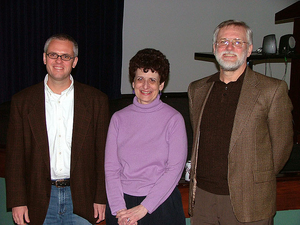Janet Murray Visits Macon

Last night, Janet H. Murray gave her lecture “Why Study Games?” as a part of the MSC Annual Arts Festival. Her answer to the titular question is because “games make us human.” Citing anthropological studies, specifically the work The Cultural Origins of Human Cognition by Micheal Tomasello, Murray suggests that the uniquely human characteristic of symbolic language that we learn through playing games leads to a shared and imagined pleasure in social recognition. In turn, humans learn the procedural rules that define human interaction. Games, in their simulations of life, help us to begin to learn about ourselves starting at a very young age.
I introduced Murray to the audience:
Good evening. On behalf of the Artists & Lecturers Committee, the Arts Festival Committee, the Office of Student Life, and the Division of Humanities, I would like to thank everyone for attending the second night of our annual Arts Festival. For those who don’t already know, I’m Jerry Lucas, and it is my privilege to introduce one of the most important and well known scholars in the field of new media today. Janet H. Murray’s work includes a recent introduction to the New Media Reader, directing Georgia Tech’s Masters Degree Program in Information Design and Technology and Ph.D. in Digital Media, and contributing to Tech’s GVU Center. But she is best known for her 1997 work Hamlet on the Holodeck, in which she synthesizes the issues surrounding new media into an accessible and entertaining format, for both scholars in the field and a popular audience.
Further distinguishing Janet Murray’s work is its concern about the impact of computers on the future of literature. Hamlet on the Holodeck speculates about the future of narrative fiction as our microprocessing technologies become more sophisticated and increasingly ubiquitous. She argues that our narrative demands have outgrown traditional literary forms, and she sees the computer as the natural medium to facilitate the convergence of various media — like film, video games, music, and the novel — into an immersive literary experience. Her work asks “How can we make this powerful new medium for multiform narrative as expressive of the writer’s voice as is the printed page?” She attempts to provide some answers by using current trends to theorize the creation of a cyberbard who will do for computer-based narrative what Homer did for epic poetry, what Shakespeare did for the theatre, and what James Joyce did for the novel.
Her work is a mixture of literary criticism, film theory, gaming trends, interactive design, and technoculture. Her thoughtful approach to these complex topics remains critical, yet accessible and optimistic. She states that we are drawn to new media just like we are drawn to art “because we need to understand the world and our place in it.” That the computer “is first and foremost a representational medium, a means for modeling the world that adds its own potent properties to the traditional media it has assimilated so quickly. [. . .] We should hasten to place this new compositional tool as firmly as possible in the hands of the storytellers.” It’s observations like this that keep me returning to her work and why she remains at the forefront of such an important field. Please join me in welcoming Janet H. Murray.
Thanks, again, to those who made it possible for me to bring such a wonderful scholar and person to Macon State College.
